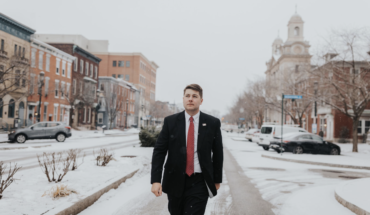A weekly column contributed by The George Mason Democrats and the George Mason College Republicans. Topics are selected by the Fourth Estate Editorial team with input from readers. This week’s opinion: Should automatic weapons be banned?
GEORGE MASON DEMOCRATS
By Andrew Millin, Chief of Staff, George Mason Democrats
Yes.
And to some extent they are.
It is important to note the distinction between automatic weapons and semi-automatic weapons. According to PolitiFact, the difference between a semi-automatic weapon and an automatic weapon is the number of rounds fired per pull of the trigger. In a semi-automatic weapon, only one round is fired per pull of the trigger. An automatic weapon can fire multiple rounds with one pull of the trigger. There is absolutely no rational explanation for having a weapon that can cause such destruction for any reason other than to kill.
Manufacturing automatic weapons for civilian use has been difficult in the United States since the 1986 Firearm Owners’ Protection Act (FOPA) was passed. However, any automatic weapon made and sold before then is totally legal to own because of a grandfathering clause. According to the Bureau of Alcohol, Tobacco, Firearms and Explosives (ATF) there are over 630,000 automatic weapons registered in the United States. These weapons can still be sold legally, which is outrageous. These are weapons designed for maximum damage and should not be available to the average citizen.
Additionally, and most importantly, the conversation about gun control should not just focus on the guns themselves. Modifications for weapons can turn weapons commonly used for hunting and self defense into mass murdering machines.
Bump stocks are the most glaring example of this. Bump stocks allow a semi-automatic weapon to go from shooting one bullet per pull of the trigger to up to 800 rounds per minute. They were created by Jeremiah Cottle 2010, an Air Force veteran and gun enthusiast. He is now the founder of Slide Fire which manufactures bump stocks. To get ATF approval for the prototype device, all he had to do was prove the device was not itself an automatic weapon. Twelve bump stock-modified rifles were found in the Las Vegas shooter’s hotel room.
Now is the time for Congress and the country to get serious about gun control because it sure is long overdue. According to the Law Center to Prevent Gun Violence, U.S. gun deaths in 2010 were equivalent to losing 85 human lives a day.
GEORGE MASON COLLEGE REPUBLICANS
By John Kielbowicz, Secretary, George Mason College Republicans
No, but for all intents and purposes they are banned. Of the over 300 million privately owned firearms in the United States only 175,977 are classified as automatic and subject to the additional restrictions levied on automatic firearms. Let’s look at the current restrictions imposed on automatic firearms:
Prior to the 1934 National Firearms Act (NFA) automatic firearms such as machine guns were not regulated any differently than any other firearm, in fact citizens could order a Thompson submachine gun through a mail order catalog. Because of prohibition and the rise of organized crime, the government sought to make it practically impossible for any private individual to be able to afford to purchase an automatic firearm. Some requirements under the NFA are to: pay a tax of $200, submit to a background check, register the firearm with the federal government, get the chief of local law enforcement to approve your application, and wait and hope the Bureau of Alcohol, Tobacco, Firearms and Explosives (ATF) approves your application.
Additional restrictions to the sale of automatic firearms were added in 1968 under the Gun Control Act (GCA). The new restrictions under the GCA prohibited the importation of automatic firearms for sale to private citizens. The GCA was later revised in 1986 under the Firearm Owners Protection Act (FOPA). FOPA made it illegal for any private citizen to purchase or own any automatic firearm manufactured after May 19, 1986.
These regulations only inhibit law-abiding citizens from exercising their constitutional rights. More gun control = higher crime rate. Chicago has some of the toughest gun control laws in the country but saw 762 firearm related murders; the highest number to date. From the period of 1993-2013 the firearm homicide rate dropped 49 percent while the number of privately owned firearms increased 56 percent. Firearm ownership is a deterrent to crime. The Second Amendment needs to be strengthened not weakened.
“A well regulated Militia, being necessary to the security of a free State, the right of the people to keep and bear Arms, shall not be infringed.”
“The George Mason College Republicans is a club dedicated to educating students on campus about the Republican Party; we are actively involved in fundraising and campaigning for local and national candidates.” –gmucollegerepublicans@gmail.com
Illustration by Mary Jane DeCarlo




